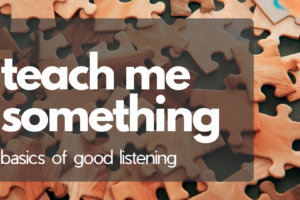I wrote a few weeks ago seeking to answer some general questions about what EMDR therapy is and how it works. As I was attempting to explain the complexities of the model, I was reminded of some of the follow-up questions I typically hear when engaging in this conversation. Many of those questions come from uncertainty and perception colored by misinformed media or a general lack of knowledge about the clinical model of EMDR. Such questions can lead to a niche stigma around EMDR and have kept some people from receiving a form of therapy that could be very helpful for them. As with most things, I think knowledge is power and the answers to these questions could help empower many to overcome their perceived barriers to genuine help they can have. With that said, let’s unpack some of the stigmas about EMDR.
“Isn’t EMDR just for really severe trauma? Surely I am not that bad off.”
When clinicians first began researching and practicing EMDR, the first population that gained popularity for the use of this treatment was those suffering from Post Traumatic Stress Disorder (PTSD). It is true to think that EMDR is one of the most helpful tools we have in treating severe trauma. However, EMDR has become our most evidence-based treatment modality in the field, and has, therefore, been adapted, tested, and proven effective with a multitude of presenting issues. Any mental or emotional (sometimes even physical) problem that you may be encountering on a regular basis can likely be approached and even resolved with EMDR therapy.
One notion that we would do well to also remember is that trauma is just as much about the way in which our memory or experience has been stored in the brain as it is the content of the original event. This means that your brain can sometimes store memories as “traumatic” even if you rationally think the event itself was “not that bad”. Take for example a story of a toddler being chased by a chihuahua. Through adult eyes, we see no threat from a yappy canine that can easily fit in your mom’s purse. However, this is not true for the toddler. All they know is they feel scared, they are in danger, and their response is to run away before those tiny teeth seek to devour their light-up sketchers. It is the toddler that stores the memory in their own brain through their lived experience, not the adult brain that recalls that memory when their children want to ask Santa for a puppy for Christmas.
This is not to say that trauma is relative and we get to throw that label around flippantly when we think of our stories. Just like all uses of language, we are to be good stewards of our diction and the meaning in which such words are meant to convey. With this in mind, we must also approach the idea that the brain can experience an event and respond to it as if it were traumatic, even if the danger was only perceived and not actual. This is where the use of EMDR can be very helpful for people even if they do not think they have experienced explicit trauma in their life. We treat the way the brain stores information, not always just the information itself.
“Isn’t EMDR just like hypnotism? Like, you’re just going to trick me into changing my memories?”
I get it – EMDR is kind of strange. But EMDR is not like hypnotism in much of its procedure. One key difference is that hypnosis seeks to bring the unconscious into work while EMDR works on a principle of dual attention to the past and present, not the unconscious. The goal of EMDR is not to change any memory, make them go away, or bury them deeper in the psyche. The goal of EMDR is to desensitize your neurological response to a distressing stimulus and reprocess the maladaptive way in which the memory was stored. There are no tricks up our sleeves here.
While I am here, I want to draw attention to the typical negative association to hypnosis. I am not a hypnotherapist, nor am I trained in any of the techniques used by clinicians that use hypnosis, but I will advocate that, like most other forms of treatment, it can be helpful for many. No, it is not like how they portray it in the movies or like the entertainers that “hypnotize” someone on stage so that they quack like a duck. It is a real form of therapy that is evidence- based and to be used by trained professionals for the betterment of a client’s mental health.
“Christians shouldn’t use EMDR because it sounds like there is no room for the Holy Spirit in that. We should probably just stick to prayer and Scripture to find healing.”
Let’s be clear. I am a Christian and I believe in the inerrancy and sufficiency of Scripture. I believe in the active role of the Holy Spirit in our prayers as He intercedes for us to the Father. I believe that it is God that brings healing and restoration to all things. I am also a Licensed Professional Counselor and I believe that God has revealed to us ways, in His intelligent design, that we are able to receive help in the present suffering we experience on this side of Heaven.
EMDR is one of those tools that we are able to use, not to go against the Truth, to actually believe it with more depth. This is where I differ as a Christian Counselor. I rely fully on the Holy Spirit in all of my EMDR sessions for Him to show up and bring healing to my clients. As a trained professional, I still have to work hard to surrender my knowledge and perception and trust wholly that it is God bringing any and all wellness, not the therapy I provide. EMDR may be the means we are using, but the end is still the glory of God!
I do not see any reason that Christians should be concerned about EMDR therapy for any theological or spiritual reasons, though I always encourage skepticism and thoughtful questions. As I have practiced EMDR for a few years now, I have had many occasions of seeing people find healing and acknowledge the presence of the Holy Spirit in the room while we “go with that”. No doubt it is by Him, not the movement of my fingers, that anyone has hope in the midst of their suffering.






Recent Comments